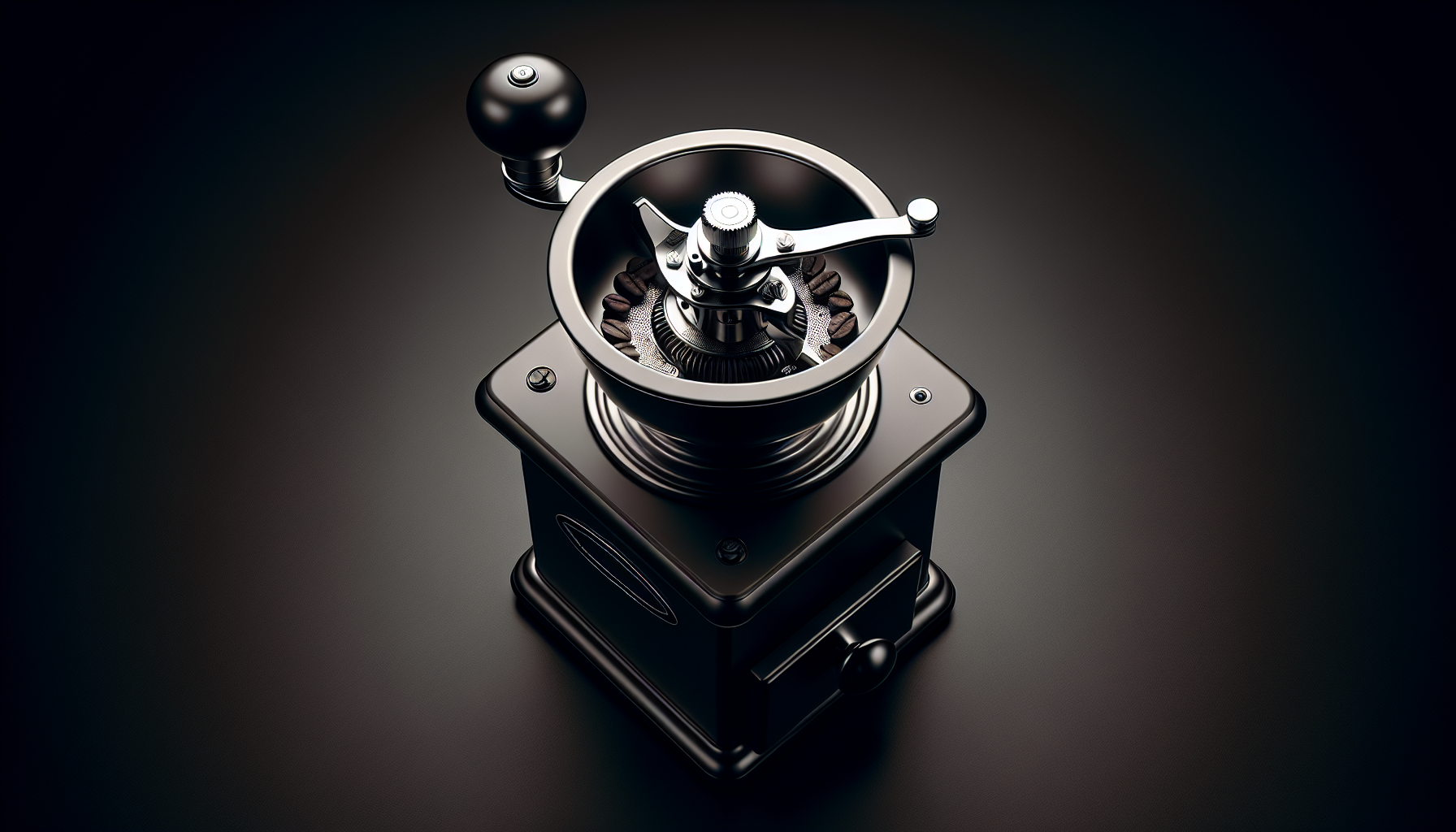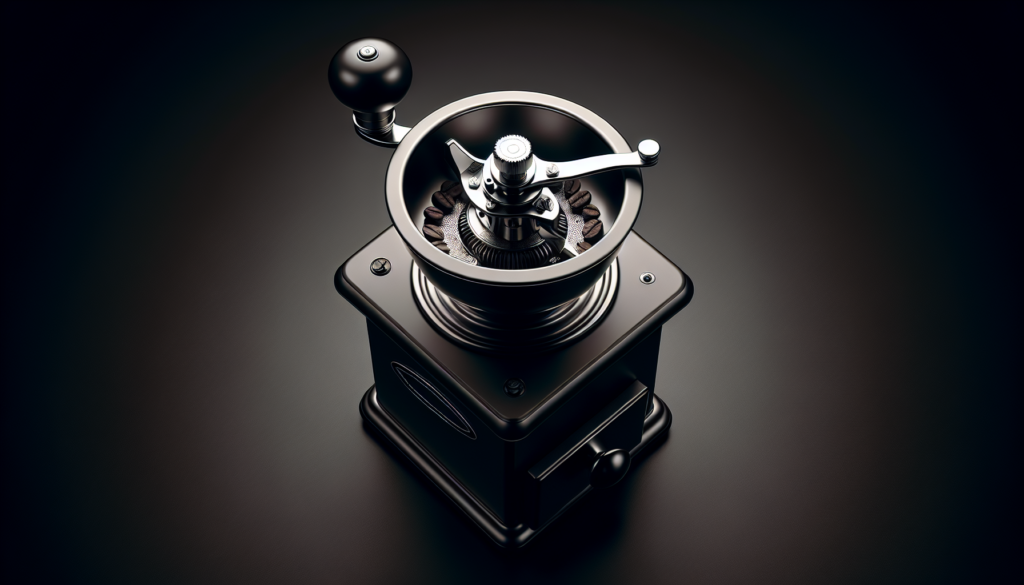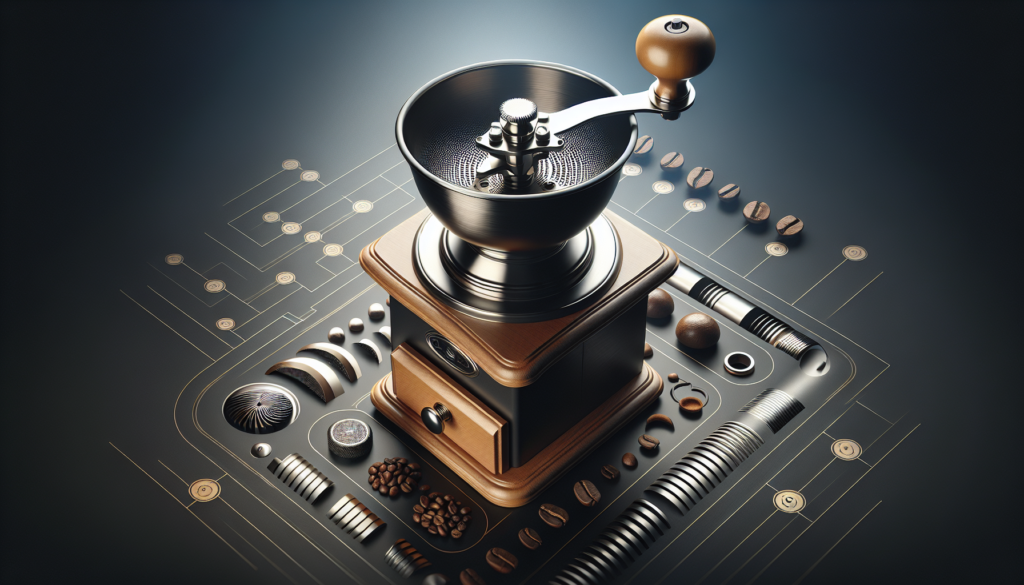
If you’re a coffee lover and are on a mission to make a perfect cup of joe each morning, then the battle between conical and flat burr coffee grinders might have caught your attention. These two types of coffee grinders have been at the forefront of discussions among coffee enthusiasts, sparking debates about which one produces the best flavor and aroma. In this article, we’ll take a closer look at the differences between conical and flat burr coffee grinders, exploring their unique features, benefits, and ultimately helping you decide which one is your perfect brewing companion. So grab a fresh cup of coffee, sit back, and let’s embark on a deep dive into this delicious world of grinders!

Overview of Coffee Grinders
Coffee grinders play a crucial role in the process of brewing a delicious cup of coffee. Whether you are an enthusiastic home barista or a seasoned coffee professional, having a high-quality grinder is essential for achieving the perfect grind consistency. In this article, we will explore the importance of coffee grinders, the different types available, and specifically delve into the fascinating world of burr grinders.
Importance of Coffee Grinders
When it comes to brewing coffee, many people focus solely on selecting the best beans and brewing equipment. However, the coffee grinder often gets overlooked, despite its vital role in the process. Grinding your coffee beans just before brewing unlocks the full potential of the beans, ensuring that you extract the most flavors and aromas.
Consistency is key when it comes to grinding coffee beans. Different brewing methods require specific grind sizes, and using the wrong grind size can negatively impact the taste and quality of your coffee. A reliable grinder allows you to achieve consistent results time and time again, enhancing your overall coffee experience.
Types of Coffee Grinders
Coffee grinders can be broadly divided into two main categories: blade grinders and burr grinders. Blade grinders operate by using a blade to chop the coffee beans into fine particles. While they may be more affordable and readily available, blade grinders often result in inconsistent particle sizes due to the uneven chopping action.
In contrast, burr grinders offer a more precise and consistent grinding experience. These grinders feature two revolving abrasive surfaces known as burrs, which crush the coffee beans into a uniform grind size. Burr grinders are further classified into two popular types: conical burr grinders and flat burr grinders.
Introduction to Burr Grinders
Burr grinders are renowned for their ability to produce consistent grind sizes, making them a favorite among coffee enthusiasts. These grinders use burrs to crush the coffee beans, creating a uniform particle size that allows for optimal extraction during the brewing process.
Definition and Functionality of Burr Grinders
A burr grinder consists of two abrasive surfaces, typically made of metal or ceramic, that are positioned close together. When coffee beans are introduced into the grinder, they pass through the gap between the burrs and are crushed into evenly sized particles. The gap between the burrs can be adjusted to achieve different grind sizes, catering to various brewing methods.
Advantages of Burr Grinders over Blade Grinders
The advantages of burr grinders over blade grinders are numerous. Firstly, burr grinders offer superior grind consistency, ensuring that each particle is of the same size. This consistency leads to improved extraction, resulting in a more flavorful and well-balanced cup of coffee.
Furthermore, burr grinders allow for more control over the grind size. With precise grind size settings, you can adjust the grinder to suit your preferred brewing method, be it French press, drip coffee, espresso, or any other method. This versatility is a significant advantage that blade grinders cannot match.
Primary Components of Burr Grinders
While various designs of burr grinders exist, they typically consist of a hopper to hold the coffee beans, a motor to power the burrs, and a grind size adjustment mechanism. Many burr grinders also feature a receptacle or portafilter holder to collect the ground coffee.

Conical Burr Grinders
Conical burr grinders are among the most popular choices for coffee aficionados. As the name suggests, these grinders feature burrs shaped like cones. The unique design and mechanics of conical burr grinders contribute to their exceptional performance.
Introduction to Conical Burr Grinders
Conical burr grinders are renowned for their ability to produce consistent and uniform grind sizes. The conical shape of the burrs allows for a longer grinding path, leading to a more efficient and controlled grinding process. This ultimately translates to a more precise extraction and a better-tasting cup of coffee.
Design and Mechanics of Conical Burr Grinders
Conical burr grinders consist of two cone-shaped burrs, one of which rotates while the other remains stationary. The rotating burr crushes the coffee beans as they pass through the gap between the burrs, resulting in a uniform grind. The angle of the burrs and the distance between them can be adjusted to achieve the desired grind size.
Benefits of Using Conical Burr Grinders
One of the significant advantages of conical burr grinders is their ability to generate less heat during the grinding process. Heat can be detrimental to the quality of coffee, as it can alter the flavors and aromas. Conical burr grinders minimize heat generation, ensuring that the integrity of your coffee beans is preserved.
Conical burr grinders also tend to be quieter compared to other types of grinders. If you value a peaceful morning routine or need to grind coffee in a shared space, the low noise levels of conical burr grinders can be a significant advantage.
Flat Burr Grinders
Flat burr grinders offer a slightly different grinding experience compared to conical burr grinders. These grinders consist of two flat, parallel burrs that grind the coffee beans when they come in contact with each other.
Introduction to Flat Burr Grinders
Flat burr grinders are highly regarded for their ability to produce consistent grind sizes, rivaling the performance of conical burr grinders. The flat burrs deliver a precise and uniform grind, ensuring a high level of extraction and an excellent cup of coffee.
Design and Mechanics of Flat Burr Grinders
Flat burr grinders feature two identical flat discs that are positioned parallel to each other. The coffee beans are crushed between these discs as they pass through the grinder, resulting in a uniform grind size. The distance between the discs can be adjusted to achieve different grind sizes to suit various brewing methods.
Advantages and Drawbacks of Flat Burr Grinders
Flat burr grinders offer several advantages worth considering. Like conical burr grinders, they excel in producing consistent grind sizes, allowing you to extract the optimal flavors from your coffee beans. They also tend to be more affordable compared to conical burr grinders, making them a popular choice for coffee enthusiasts on a budget.
However, there are a few drawbacks to consider when it comes to flat burr grinders. Due to their design, flat burr grinders can generate more heat during the grinding process compared to conical burr grinders. This heat can potentially affect the flavors and aromas of the coffee, leading to a less desirable cup.
Grind Consistency
Achieving a consistent grind size is crucial for brewing the perfect cup of coffee. Consistency ensures that the extraction process is optimized, allowing for a balanced and flavorful beverage. Let’s compare the grind consistency between conical and flat burr grinders.
Importance of Grind Consistency
When brewing coffee, different brewing methods require specific grind sizes. Whether you are using a French press, drip coffee maker, espresso machine, or any other brewing equipment, having a consistent grind size is vital. Inconsistent grind sizes can result in over-extraction or under-extraction, leading to a bitter or weak cup of coffee.
Comparison of Grind Consistency between Conical and Flat Burr Grinders
Both conical and flat burr grinders excel in providing consistent grind sizes. However, conical burr grinders are often praised for their superior performance in this aspect. The longer grinding path and the conical shape of the burrs in conical grinders contribute to a more efficient and uniform grinding process.
On the other hand, while flat burr grinders offer excellent grind consistency, they may require more adjustments to achieve the desired grind size. This is primarily due to the design and mechanics of flat burr grinders, as the parallel discs may introduce slight variations in particle size.
Factors Affecting Grind Consistency
Several factors can affect the grind consistency of both conical and flat burr grinders. The quality and sharpness of the burrs play a crucial role in ensuring consistent results. Additionally, the stability and precision of the grind size adjustment mechanism, as well as the quality of the motor, can influence the grind consistency.
Grind Size Options
Different brewing methods require specific grind sizes to achieve optimal extraction and flavor. Let’s explore the available grind size options in both conical and flat burr grinders.
Available Grind Size Options in Conical Burr Grinders
Conical burr grinders generally offer a wide range of grind size options, making them suitable for various brewing methods. From coarse grinds for French press to fine grinds for espresso, conical burr grinders can cater to all your coffee needs. The precise grind size adjustment mechanism allows you to dial in the perfect setting for your preferred brewing method.
Available Grind Size Options in Flat Burr Grinders
Similar to conical burr grinders, flat burr grinders provide a vast selection of grind size options. From coarse grinds for cold brew to fine grinds for Turkish coffee, flat burr grinders can cover a wide range of brewing needs. With accurate adjustments, you can consistently achieve the perfect grind size to enhance your coffee brewing experience.
Choosing the Right Grind Size for Your Brewing Method
Choosing the right grind size for your brewing method is crucial to achieving the best results. As a general rule, coarser grinds work well for brewing methods with longer steeping times, such as French press or cold brew. Finer grinds are suitable for methods with shorter extraction times, such as espresso or AeroPress.
Experimentation is key to finding the ideal grind size for your preferred brewing method. Start with a recommended grind size, then make slight adjustments until you achieve your desired flavor profile. Remember, finding your perfect grind size is a journey of discovery and personal preference.
Heat Generation
Heat can significantly impact the taste and quality of your coffee grounds. Let’s explore the effects of heat on coffee grounds and how it relates to conical and flat burr grinders.
Effects of Heat on Coffee Grounds
Heat can cause chemical changes in coffee grounds, leading to alterations in flavor, aroma, and overall quality. Excessive heat can result in over-extraction, resulting in a bitter and harsh taste. It can also accelerate the oxidation process, reducing the freshness and vibrant flavors of your coffee.
Heat Generation in Conical Burr Grinders
Conical burr grinders are known for their ability to generate less heat compared to other types of grinders. The longer grinding path and the reduced friction between the burrs contribute to minimizing heat production during the grinding process. This characteristic is advantageous for preserving the delicate flavors and aromas of your coffee.
Heat Generation in Flat Burr Grinders
While flat burr grinders can provide excellent grind consistency, they tend to generate more heat compared to conical burr grinders. The parallel discs can create more friction during grinding, leading to increased heat production. While this may not be a major concern for all coffee enthusiasts, it is worth considering if preserving the delicate flavors of your coffee is a top priority.
Noise Levels
Grinding coffee in the early morning can sometimes disturb the peace of your household or workplace. Let’s explore the noise levels of conical and flat burr grinders and the factors that may affect them.
Noise Levels of Conical Burr Grinders
Conical burr grinders are generally known for their relatively quiet operation. The mechanics of conical burr grinders produce less noise compared to blade grinders or other types of burr grinders. This makes them an ideal choice for coffee lovers who value a peaceful coffee experience or need to grind their beans in shared spaces.
Noise Levels of Flat Burr Grinders
Compared to conical burr grinders, flat burr grinders may produce slightly more noise during the grinding process. The parallel discs in flat burr grinders can create more vibrations and audible sounds. While the noise levels may not be significantly high, it is important to consider if you prefer a quieter grinding experience.
Factors Affecting the Noise Levels
Several factors can affect the noise levels of both conical and flat burr grinders. The build quality of the grinder, the materials used, and the stability of its components can all contribute to the overall noise produced. Additionally, the speed of the motor and the size and weight of the burrs can influence the noise levels during grinding.
Cleaning and Maintenance
Proper cleaning and maintenance are essential for keeping your coffee grinder in optimal condition and prolonging its lifespan. Let’s explore the recommended cleaning processes and maintenance tips for both conical and flat burr grinders.
Cleaning Process for Conical Burr Grinders
Cleaning a conical burr grinder is a straightforward process. Begin by removing any leftover coffee grounds from the hopper and the grinding chamber. Use a soft brush to clean the burrs, making sure to remove any residual coffee particles. Some models may allow you to remove the burrs for more thorough cleaning. Lastly, wipe the exterior of the grinder with a damp cloth, ensuring it is completely dry before use.
Cleaning Process for Flat Burr Grinders
Cleaning a flat burr grinder follows a similar process to that of conical burr grinders. Begin by removing any remaining coffee grounds from the hopper and the grinding chamber. Use a soft brush to clean the burrs, focusing on removing any trapped coffee particles. Some flat burr grinders may have removable burrs, allowing for more efficient cleaning. Wipe the exterior of the grinder with a damp cloth, ensuring it is fully dry before use.
Maintenance Tips for Both Types of Grinders
Regular maintenance is key to keeping your burr grinder in top shape. In addition to routine cleaning, there are a few maintenance tips to keep in mind. It is recommended to periodically lubricate the moving parts of the grinder to ensure smooth operation. Additionally, consider replacing the burrs when they become worn out to maintain optimal performance. Following these tips will help prolong the lifespan and performance of your burr grinder.
Price Range and Durability
When choosing a coffee grinder, price and durability are important factors to consider. Let’s compare the price ranges and durability of conical and flat burr grinders.
Price Range of Conical Burr Grinders
Conical burr grinders are available in a wide range of price points. Entry-level models can be found for as little as $50, offering reliable performance and grind consistency for those on a budget. More high-end conical burr grinders with additional features and superior build quality can range anywhere from $100 to $500.
Price Range of Flat Burr Grinders
Like conical burr grinders, flat burr grinders also come in various price ranges. The entry-level models typically start around $80 and offer decent performance and grind consistency. As you move up in the price range, you can find more advanced flat burr grinders with improved features and construction, reaching prices of $300 or more.
Comparison of Durability between the Two Types
When it comes to durability, both conical and flat burr grinders can last for years with proper care and maintenance. The longevity of the grinder largely depends on the build quality and materials used in its construction. Higher-end models often feature sturdier components and are built to withstand frequent use. It is advisable to read reviews and choose a reputable brand to ensure a durable and long-lasting grinder.
In conclusion, when selecting a coffee grinder, it is essential to consider your specific needs and preferences. Both conical and flat burr grinders offer excellent grind consistency and the ability to unlock the full potential of your coffee beans. By understanding the differences between the two types, you can make an informed decision and enjoy a superior coffee experience every time you brew.